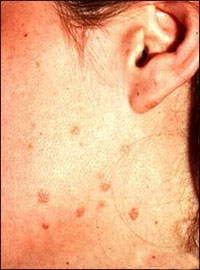





 Order Treatment Online
Order Treatment Online
 Diseases and Conditions
Diseases and Conditions
Warts are small, usually painless growths on the skin caused by a virus called human papillomavirus (HPV). They are generally harmless. However, warts can be disfiguring and embarrassing, and occasionally they itch or hurt (particularly on the feet).
The different types of warts include:
· Common warts usually appear on the hands, but can appear anywhere.
· Flat warts are generally found on the face and forehead. They are common in children, less common in teens, and rare in adults.
· Genital warts (condyloma) are usually found on the genitals, in the pubic area, and in the area between the thighs, but they can also appear inside the vagina and anal canal. (See: Genital warts for more information)
· Plantar warts are found on the soles of the feet.
· Subungual and periungual warts appear under and around the fingernails or toenails.
The typical wart is a raised round or oval growth on the skin with a rough surface. Compared with the surrounding normal skin, warts may appear light, dark, or black (rare). Most adults are familiar with the look of a typical wart and have little trouble recognizing it. Unusual warts with smooth surfaces or flat warts in children may be more difficult for parents to recognize.
Common warts tend to cause no discomfort unless they are in areas of repeated friction or pressure. Plantar warts, for example, can become extremely painful. Large numbers of plantar warts on the foot may cause difficulty walking or running.
Some warts will disappear without treatment, although it can sometimes take a couple of years. Treated or not, warts that go away often reappear. All warts can spread from one part of your own body to another.
Unsightly or painful warts can be treated. Warts around and under your nails are much more difficult to cure than warts in other places.
· Abnormally dark or light skin surrounding the lesion
· Numerous small, smooth, flat (pinhead sized) lesions on forehead, cheeks, arms, or legs
· Rough growths around or under fingernails or toenails
· Rough, round, or oval lesions on soles of feet -- flat to slightly raised -- painful to pressure
· Small, hard, flat or raised skin lesion or lump
Warts can generally be diagnosed simply by their location and appearance. Your doctor may want to cut into a wart (called a biopsy) to confirm that it is not a corn, callus, skin cancer, or other similar-appearing growth.
Over-the-counter medications can remove warts. These are applied to the wart every day for several weeks. Do NOT use these medications on your face or genitals. It helps to file the wart down when damp (for example, after a bath or shower) before applying these medications. Do NOT treat warts on your face or genitals yourself. See your health care provider.
Pain and pressure from plantar warts can be treated with special cushions that are available at drug stores.
Your health care provider may use stronger (prescription) medications, such as podophyllin or salicylic acid, for removal of persistent warts. Surgical removal or removal by freezing (cryotherapy), burning (electrocautery), or laser treatment may be needed.
Immunotherapy, done by injecting a substance that causes an allergic reaction, may also be considered by your health care provider. A topical medication called imiquimod may also be used.
A vaccine called Gardasil prevents infection against the strains of viruses that often cause genital warts and cervical cancer in women.
Do NOT attempt to remove a wart yourself by burning, cutting, tearing, picking, or any other method.
